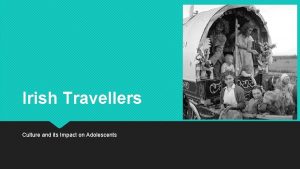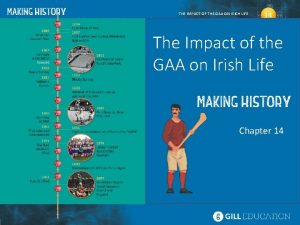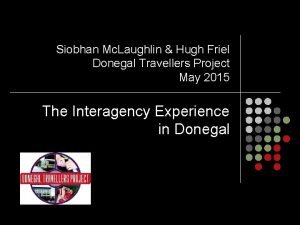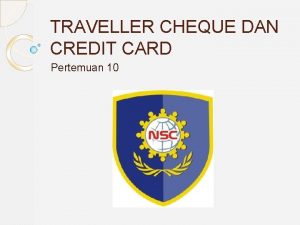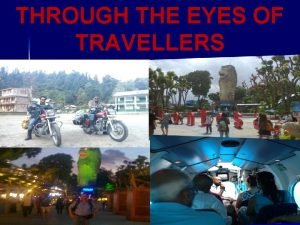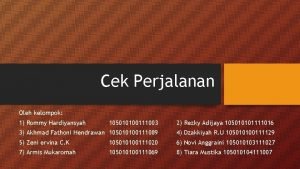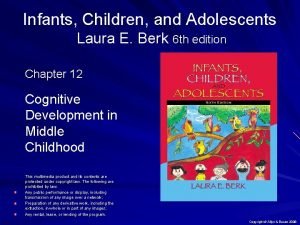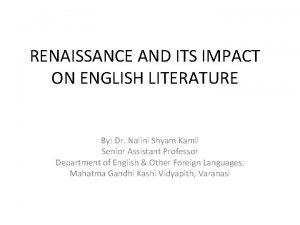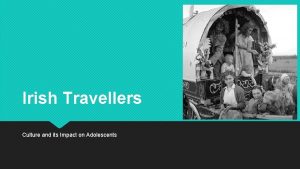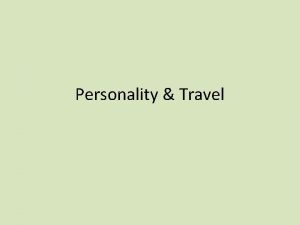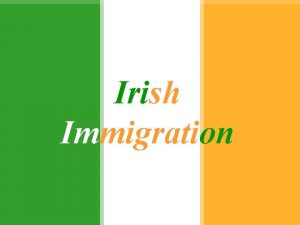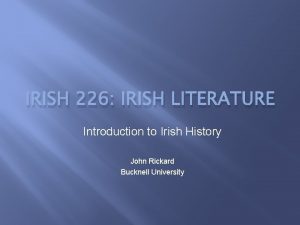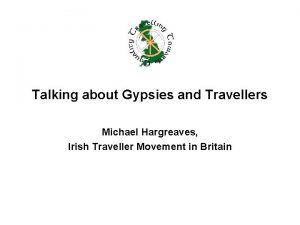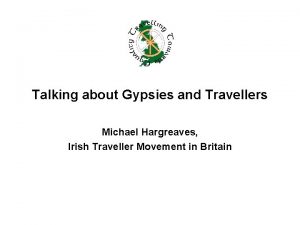Irish Travellers Culture and its Impact on Adolescents










- Slides: 10

Irish Travellers Culture and its Impact on Adolescents

Introduction A distinct ethnic group with a traveling population of approximately 22, 369 in Ireland, and 61, 193 in Great Britain. Travellers separated from the settled Irish community at least 1000 years ago. A Catholic population with extremely conservative values. Face intense prejudice and discrimination in Britain and Ireland, as well as across Europe where they travel for work. At great risk for poverty, systematic discrimination, and domestic violence. Incredibly secretive community.

Public Perception Considered one of the most discriminated-against ethnic groups in Ireland. Travellers are viewed by settled people as anti-social, misfits, and drop-outs. Settled people stereotype Travellers as criminals who settle illegally on public land. Prejudice against Travellers is considered to be the last unchallenged form of racism in Britain. 81% of Travellers report being the victims of racist incidents, comments, or attitudes. 65% of Travellers report having hidden their identity as a Traveller because of fears of how they’d be treated.

Education Children are often out of school for long periods of time. Average attendance of 75%. 12, 000 Traveller students of secondary school age are not registered in school. The average student drops out around middle school. Boys join their fathers at work, girls stay at home to care for their younger siblings. 22. 5% of Traveller adolescents earn more than 5 GCSE qualifications Half the national average of 54. 9% Traveller parents are reluctant to engage with the state education system. Forced evictions of Traveller communities impair access to education. Ranked at the bottom of Irish society in rates of education.

Gender Roles The man is always considered to be the head of the family. Adolescent boys are given a lot of freedom compared to adolescent girls. Men are expected to take responsibility for supporting the family, while women take responsibility for the home and children. Women are expect to be, or at least appear, subservient to men. Gypsy and Traveller women generally marry between the ages of 16 and 19 and become mothers soon after. Research finds that Gypsy men can become defensive about their traditional masculine gender roles in the face of outside pressures with behaviors becoming more violent as their masculine behavior was challenged. Domestic abuse is accepted as normal for many women. A pilot project in Leeds found that many women from the Traveller community were surprised to learn that the behaviors they had experienced for granted were forms of abuse. Brides receive a severe beating on their wedding night.

Gender Roles in Adolescence VIDEO: A CANDID LOOK AT GENDER ROLES IN TRAVELLER ADOLESCENCE “GRABBING”

Rites of Passage Travellers are devout Catholics, and religious ceremonies mark important milestones in Gypsy life. The most important events in young Gypsy life happen in adolescence. First Communion Wedding Women report these events as being the only things they have to look forward to outside of family life, so they are often executed in a way most would consider to be over the top. VIDEO: JACINTA’S FIRST COMMUNION

Rites of Passage MARRIAGE Marriages are arranged by the family, sometimes at birth. Traveller men are usually over the age of 21 when they get married, while girls average between 15 and 18 -years-old. A dowry is expected to be paid for the bride, sometimes up to $200, 000. Less affluent Travellers are beginning to marry outside of the culture for this reason. In an effort to keep the culture homogenous, marriage between closely related family members is often permitted. First and second cousins. Weddings are usually held around Christmas, as there is a greater chance of other Travellers being in the villages. VIDEO: A LOOK INSIDE TRAVELLER WEDDINGS

Health and Mental Health A 2007 study shows that Travellers are in significantly poorer health than the rest of Ireland. More than 50% of Travellers do not live past the age of 39. 80% do not live page 65. The birth rate among Gypsies and Travellers is the highest ever recorded for any community in Europe: 33. 32 per 1000. 22% of Traveller deaths occur from traffic accidents. 10 x the national average, and the leading cause of death of Traveller males. Young men begin drinking in their early teens, leaving them prone to risky behaviors like drunk driving. 32% of Travellers who die every year are adolescents (under 25), compared to 2. 6% for the general Irish population. Young Traveller men are 6 x more likely to commit suicide than the general population. Travellers have a high infant mortality rate. 10% of Traveller children die before their second birthday, 10 x the national average. Researchers have attributed this to the prevalence of teenage parents, who are more likely to have a baby die from SIDS.

References Countries and Their Cultures. (2014, January 1). Retrieved November 25, 2014, from http: //www. everyculture. com/wc/Norway-to. Russia/Roma. html#b Domestic Abuse and Equality: Gypsy and Traveller Women. (2010, October 1). Retrieved December 1, 2014, from http: //www. equalityhumanrights. com/sites/default/files/documents/Wales/domestic_abuse_and_gypsy_travellers. pdf Farrell, T. (2011). Access to education for Traveller children. (cover story). Children & Young People Now, 26 -27 Gypsy and Traveller Culture. (n. d. ). Retrieved December 1, 2014, from http: //www. plymouth. gov. uk/gypsy_and_traveller_culture. pdf Hayes, M. (2006). Indigenous Otherness: Some Aspects of Irish Traveller Social History. Éire-Ireland, 41(3/4), 133 -161. Kelleher, C. , Whelan, J. , Daly, L. , & Fitzpatrick, P. (2012). Socio-demographic, Environmental, Lifestyle And Psychosocial Factors Predict Self Rated Health In Irish Travellers, A Minority Nomadic Population. Health & Place, 18(2), 330 -338. Kruckenberg, K. (2011). ON THE ROAD TO RECOGNITION: IRISH TRAVELLERS' QUEST FOR ETHNIC IDENTITY. St. Louis University Public Law Review, 31(1), 301 -323. Racism Towards Gypsies and Travellers: A Snapshot of Experiences in Devon. (2013, September 1). Retrieved November 22, 2014, from http: //www. devon. gov. uk/racism_towards_gypsies_and_travellers_2013. pdf The Traveller Community. (2013, January 1). Retrieved November 29, 2014, from http: //www. travellersuicide. ie/about_travellingcommunity
 Irish travellers grabbing
Irish travellers grabbing Impacts of the gaa
Impacts of the gaa Donegal travellers project
Donegal travellers project Mekanisme travellers cheque
Mekanisme travellers cheque Through the eyes of travellers project
Through the eyes of travellers project Contoh gambar travellers cheque
Contoh gambar travellers cheque Travellers surrey
Travellers surrey Berk 8th edition
Berk 8th edition Lara berk
Lara berk What is the difference between courting and dating
What is the difference between courting and dating Influence of renaissance on english literature
Influence of renaissance on english literature
